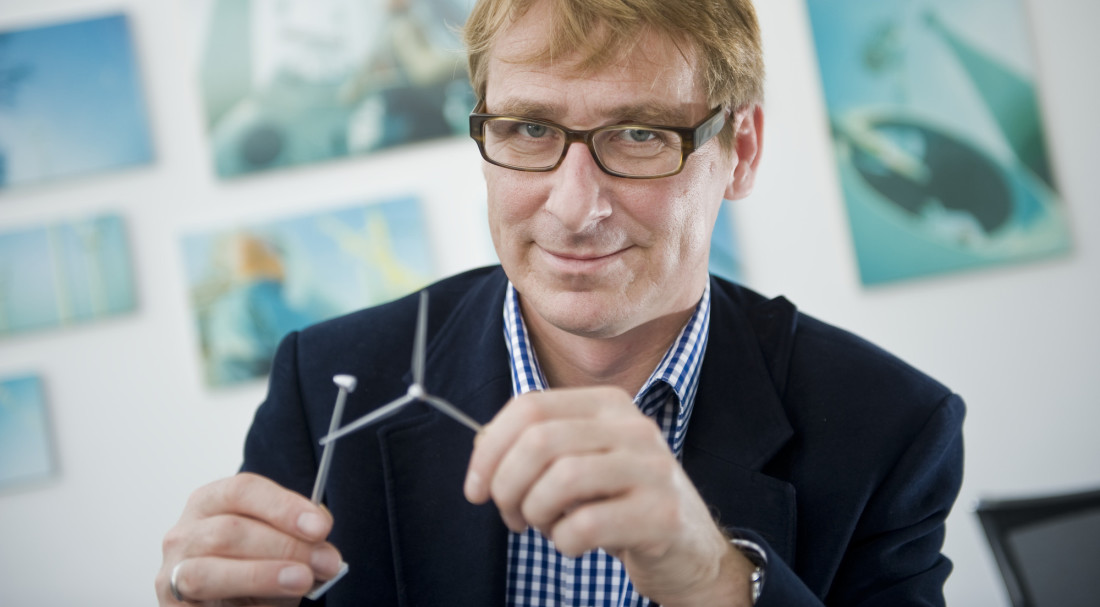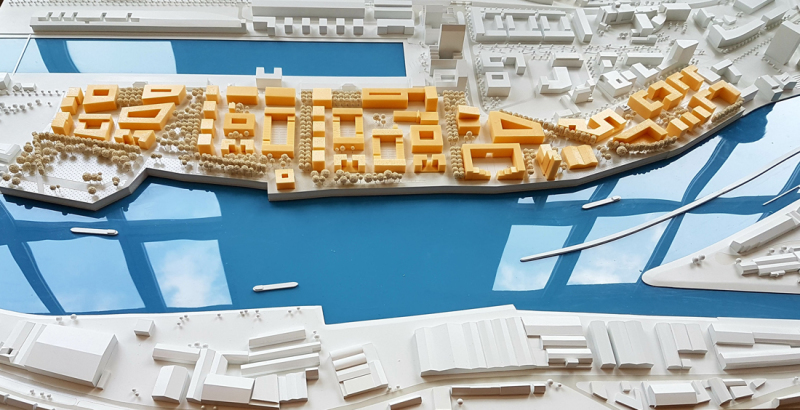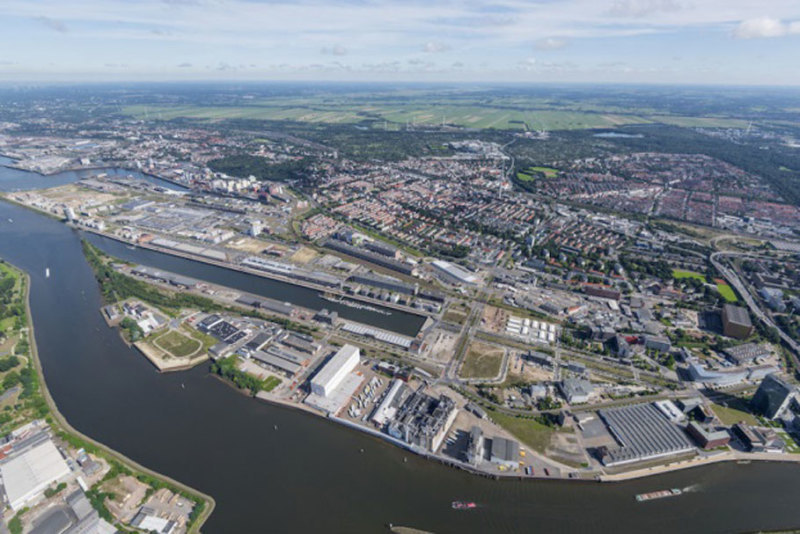“By 2040, the Überseeinsel peninsula will be the quarter where people want to live and work!”
Überseestadt (New Harbour District)On the south side of the Europahafen, it’s full steam ahead for a new urban development showpiece: the 15-hectare former Kellogg’s premises known as the Überseeinsel. The centrality of the location, which forms part of the 41-hectare southern section of the Europahafen, its proximity to the water and its many historical industrial buildings provide the framework for a characterful quarter that is equipped for the future. The former business premises of Kellogg’s now has investment backing from Europa Immobilien GmbH, represented by Dr Klaus Meier. In our interview, he talks about opportunities, challenges, and visions for the future for the Überseeinsel.

Dr Meier, the Überseeinsel urban development project is currently the talk of the town. Where exactly is the Überseeinsel?
The Überseeinsel is part of the southern section of the Europahafen, i.e. the former business premises of Kellogg’s. The entire southern section is bordered by the Europahafen to the north, and the River Weser to the south, and is a 41-hectare peninsula, meaning that it is surrounded by water on three sides. The US company Kellogg’s manufactured many of its products, including cornflakes, on 15 hectares of this section for more than 50 years, and there are still a lot of sheds and industrial buildings on the site. Kellogg’s closure of its production facilities in November 2017 gave rise to a new situation and the search was on for a sustainable concept for the future. Preliminary studies bore the working title ‘Europahafen - South Side’, but now we speak more fittingly of the southern sector of the Europahafen and of the Überseeinsel.
At the end of May, you signed an urban development agreement with Bremen City Council (represented by Dr Joachim Lohse, Senator for the Environment, Construction and Transport) to develop the Überseeinsel peninsula. This took place as part of a special joint meeting with the municipal deputations for the Environment, Construction, Transport, Urban Development, Energy, and Agriculture as well as for Economic Affairs, Labour, and Ports. Can you tell me about the content and substance of the agreement, including its specific plans and objectives?
The agreement sets out the rough framework for the next few years and describes the results of the urban development competition. As an investor, Europa-Immobilien GmbH also declares its commitment to the findings of the preliminary studies and gives a broad-brush statement of its construction intentions i.e. the type and scale of the buildings. The agreement also stipulates that childcare centres and a primary and middle school are desired, and that appropriate space will be made available for these. Finally, it gives a rough outline of the proportion of land devoted to living and working, relative to the proportion available for public use.
Were there any reservations or hurdles to be overcome when putting the agreement together?
There was a great convergence of interests among the signatories to the agreement, and the negotiation process was really very pleasant. This is remarkable actually as in business, agreements are usually thrashed out in an adversarial process, with interest-based bargaining and tough negotiations on prices. Luckily, this was not the case here due to the parallel interests of the Senator for Economic Affairs, Labour and Ports and the Senator for the Environment, Construction, and Transport.
How much consideration is given to the master plan for the Überseestadt in the agreement?
The Überseestadt master plan is of course the basis, but didn’t originally have anything to say about the Überseeinsel peninsula. In this respect, our agreement is an update, but one that needs to be fleshed out further, as both sides are aware. The next steps are a framework plan to add substance and detail, followed by robust, detailed development plans for various zones.
Which architecture firms are involved and how was the competition structured?
The aim of the competition was not to find a single winner but to find a plan, with the intention of involving several firms in this from the outset. Six firms were initially invited to take part: two from Berlin and one each from Bremen, Copenhagen, Rotterdam and Vienna. We approached the project from an international perspective in the belief that it was critical for Danish and Dutch experiences and ideas from the field of seaport development to also feed into the project. Other interesting aspects come from innovative architectural practices in the Austrian and German capitals. Last but not least, we urgently need the local knowledge of Bremen that regional architects can provide. We then selected three architecture firms for our shortlist: the OMP Group from Bremen, COBE from Copenhagen, and SMAQ from Berlin.
What do the ideas look like in concrete terms?
The basic concept bears the hallmark of Berlin firm SMAQ. Another focus is brought into play by the Danish design, as a core element of the plans is the preservation of the Kellogg’s silo facility, which is seen as important in terms of urban aesthetics. This assimilation into the overall architecture on the Überseeinsel peninsula is an idea that we want to take from the Danish design – which is a good fit as the plans for the group of buildings at the head of the marina are also by COBE. It simply makes sense to have everything cast from the same mould.

How have the architects from Bremen contributed to the project?
A large part of the refinements for many sub-topics come from Bremen and deal with issues such as how to achieve the architectural transition between the Weser and the Europahafen marina. Bremen architects have been equally involved in the development of the quarter, as only a local firm really knows what local families want and what their housing needs are: namely a terraced house with a small garden.
Do you want to design the Überseeinsel peninsula so that it is of interest to families?
Yes, actually one of the themes of the quarter is ‘Family’. In plain language: we explicitly do not want buildings that are mainstream in the modern property market. This would be 80 to 120-square metre owner-occupied housing for couples with no children, which would be very expensive in this location and absolutely impossible to finance without two incomes. This is our plan, but will be exciting to see how we can actually realise this ambitious project.
Why is this project important to you, and why are you involved in the Überseeinsel peninsula and acting as an investor?
Seven or eight years ago, we purchased a neighbouring plot from Kellogg’s for our wpd company headquarters, so we already have a strong geographical connection to this special pocket of land. At that time, we also agreed a pre-emption right for a sizeable sub-area, as we could imagine from the outset expanding our company at this very spot. At the end of 2017, we founded the real estate project development company Europa Immobilien GmbH right next to our core business. The new company focuses specifically on the Überseeinsel peninsula. What can we do with this plot of land, which has always had a strongly industrial character? This is the question that we have been working on for the past year. We only started the intensive planning stage in November 2017; the legally binding sale and purchase agreement was signed in March 2018, and the land will be transferred to us on 1 July 2018.
You come from the wind energy sector – how does that fit with the Überseeinsel peninsula?
We are looking for answers to questions. The first question we have is how we link up the thermal energy/heating and driving/traffic sectors with our core business, the electricity sector. We are hoping to use the Überseeinsel quarter as an example of how these three sectors can be intertwined. The best-case scenario would be a carbon-free quarter, although this would involve a great many other aspects such as the integration of local public transport and ensuring that the area is suitable for cyclists and pedestrians. Another significant question for us is how we design the concept to make it attractive to Bremen inhabitants. Would it be of interest to our employees, for example, who are currently moving to Hude, Oldenburg and Achim because these are the only places where they can find affordable housing with a garden, and who see the longer commute as a price worth paying? We will only be able to answer these questions in a few years’ time.
This project could serve as a model in many regards. What does that mean from a planning perspective?
Our goals are challenging, and the whole project is very ambitious. We have a complex dilemma to solve: discerning architecture on expensive land, set within a pioneering energy structure – nothing about this project initially suggests that it will be affordable for families. Whether or not it is a role model will be decided by those who follow, not by us.

Who else is involved in the project? How much of the onus is on policymakers?
Working closely with the public bodies responsible for construction, education, and economic affairs is a great opportunity to jointly develop something amazing. We are currently in the process of putting together our best in-house team for the project, which should be up and running by the second half of 2018. We will initially have six to eight employees in the core team, with a few additional colleagues available to assist with any special issues. The next step will then be to assemble project teams for the individual sub-projects. In any case we are already looking forward to working with the local authorities and the specialist planners.
Moving on to the timetable: what are your specific next steps and interim targets?
The first thing that we have to look at is housing, and also new buildings for companies. We could have a development plan ready at some stage during the first half of 2020, and we’ve set our sights on 2021/22 for the ground-breaking ceremony. Our aim is to start on a large initial section during this time corridor – around a third of the total area. The other areas will then be developed on a partly overlapping basis, so that the entire construction project could be completed between 2027 and 2030. However, ideally, the plans for two or three existing properties and a school will be given priority and building permission for these secured first. We envisage that construction will start in early 2019. The tight timeline means this would admittedly be a bit of a stress test for all involved, but not impossible.
Let’s look into the future: how do you picture the Überseeinsel in 2040 – do you have a vision?
The streets in the quarter will have no cars, but plenty of children. It will enjoy pure water from the River Weser and clean air, and will not generate any harmful emissions. The local infrastructure will be shaped around small shops: a bakery, a hair salon, a fishmonger, and even a market for organic and local products. The Überseeinsel peninsula will mature into a sought-after, charming, and liveable district that is comparable to the Ostertor or Wachmannstrassen districts, for example, or the area around the Findorff market. By 2040, the Überseeinsel peninsula will be the quarter where people want to live and work.
On 29 May 2018, the urban development agreement for the Überseeinsel peninsula was concluded between Bremen City Council and Dr Klaus Meier as representative of Europa Immobilien GmbH. Dr Meier is the CEO of Europa Immobilien GmbH, managing partner of wpd windmanager GmbH & Co. KG, and, since 24 May 2018, chairman of the supervisory board of BLG AG (Bremen-based warehouse company).
For further information on Überseestadt Bremen, please contact Dagmar Nordhausen, +49 (0)421 9600 252, dagmar.nordhausen@wfb-bremen.de and Jons Abel, +49 (0)421 9600 613, jons.abel@wfb-bremen.de.
Success Stories
Bremen’s Economy in Figures: Statistics 2025
The State of Bremen is a strong economic hub. A look at the latest statistics highlights its economic strength — summarising key data such as cargo volumes, export performance, industry turnover, and more.
Learn moreMedium-Sized Companies in Bremen Showcasing the Full Range of the Local Economy
Medium-sized companies form the backbone of Bremen’s economy. They create jobs and produce goods that are in demand worldwide. Here is a selection of ten businesses that illustrate the diversity of Bremen’s economic landscape.
Learn moreTwelve international food and beverage companies in Bremen
Becks and Melitta may be high-profile brands, but international food and beverage companies also manufacture lots of other products in Bremen and Bremerhaven. Here are twelve examples.
Learn more